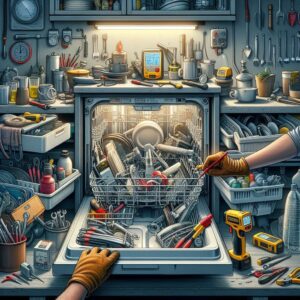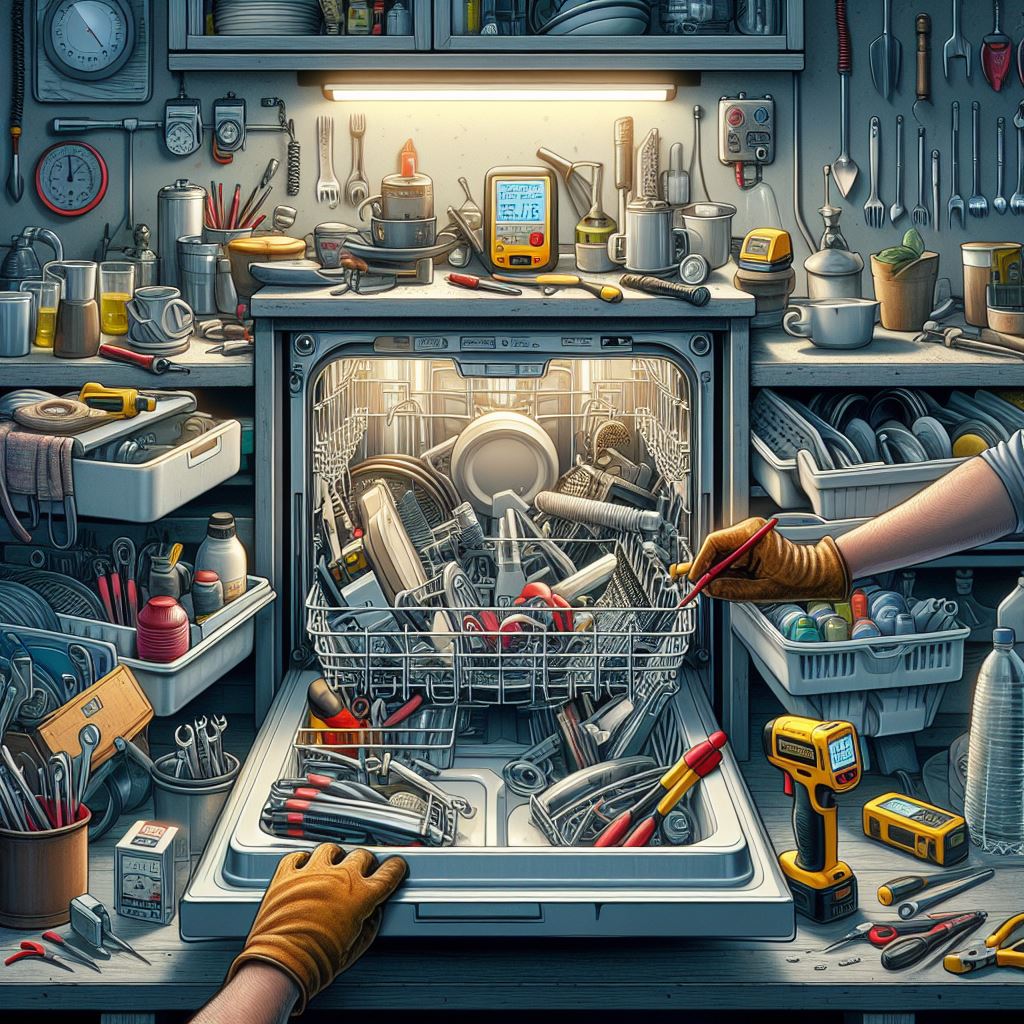Dishwashers are invaluable appliances in modern kitchens, offering convenience and efficiency in cleaning dishes. However, like any appliance, dishwashers can encounter issues from time to time. The good news is that many common dishwasher problems can be resolved with simple do-it-yourself (DIY) fixes, saving you time and money on professional repairs. In this comprehensive guide, we’ll explore various troubleshooting techniques and DIY repairs to address common dishwasher issues effectively.

Unclogging the Drain
One of the most common dishwasher problems is a clogged drain, which can cause water to pool at the bottom of the dishwasher or lead to drainage issues. To unclog the drain, follow these steps:
- Start by disconnecting the dishwasher from power and water sources.
- Remove the bottom rack to access the drain.
- Check for any debris, food particles, or foreign objects blocking the drain.
- Use a wet/dry vacuum or a wire coat hanger to remove the obstruction.
- Once the drain is clear, reassemble the dishwasher and run a test cycle to ensure proper drainage.
Cleaning the Spray Arms
If you notice that your dishes aren’t getting clean or are coming out with food residue, the spray arms may be clogged. To clean the spray arms, follow these steps:
- Remove the bottom rack to access the spray arms.
- Inspect the spray arms for any debris or mineral buildup.
- Use a toothpick or small brush to remove any obstructions from the spray arm nozzles.
- Soak the spray arms in a mixture of vinegar and water to dissolve mineral deposits.
- Once clean, reassemble the spray arms and run a test cycle to ensure proper water flow and cleaning performance.
See price for Midea MDF18A1AST dishwasher https://amzn.to/4cg668Q
Checking the Door Seal
A faulty door seal can result in leaks or water seepage during the dishwasher cycle. To check the door seal, follow these steps:
- Inspect the door seal for any signs of wear, damage, or deformation.
- Clean the door seal with warm, soapy water to remove any dirt or debris.
- If the door seal is damaged or worn out, replace it with a new one.
- Close the dishwasher door and run a test cycle to verify that the seal is functioning properly and preventing leaks.
See price for COMFEE’ Countertop Dishwasher https://amzn.to/491b2vo
Addressing Limescale Buildup
Limescale buildup can affect the performance of your dishwasher and lead to issues such as poor cleaning or reduced water flow. To address limescale buildup, follow these steps:
- Empty the dishwasher and remove any dishes or utensils.
- Place a cup of white vinegar on the top rack of the dishwasher.
- Run a hot water cycle with the dishwasher empty to allow the vinegar to dissolve limescale deposits.
- Once the cycle is complete, wipe down the interior of the dishwasher with a damp cloth to remove any remaining limescale residue.
- Repeat this process regularly to prevent limescale buildup and maintain optimal dishwasher performance.
Adjusting the Dishwasher Level
If your dishwasher is not level, it may cause water leakage or uneven cleaning. To adjust the dishwasher level, follow these steps:
- Use a bubble level to check the alignment of the dishwasher.
- If the dishwasher is not level, adjust the leveling feet located at the front or bottom of the appliance.
- Turn the leveling feet clockwise to raise the dishwasher or counterclockwise to lower it until it is level.
- Once the dishwasher is level, tighten the locking nuts to secure the leveling feet in place.
- Run a test cycle to ensure that the dishwasher operates smoothly and without any leaks.
Troubleshooting Error Codes
Many modern dishwashers are equipped with error code displays to indicate potential issues with the appliance. If you encounter an error code on your dishwasher’s control panel, consult the owner’s manual for troubleshooting tips and recommendations. Common error codes may indicate issues such as water inlet problems, drain pump malfunctions, or sensor errors. By identifying and addressing the underlying cause of the error code, you can often resolve the issue without the need for professional assistance.
See price for RCA RZ0842 Front Control-Built in FULLSIZE Dishwasher https://amzn.to/3wV6wBn
Replacing Faulty Components
In some cases, DIY repairs may require replacing faulty components such as the drain pump, water inlet valve, or detergent dispenser. Before attempting to replace any parts, ensure that you have the necessary tools and replacement parts on hand. Consult the dishwasher’s service manual or manufacturer’s instructions for guidance on disassembly, component identification, and installation procedures. If you’re unsure about performing complex repairs, consider seeking assistance from a qualified technician or appliance repair professional to avoid causing further damage to the dishwasher.
Conclusion
With proper maintenance and timely DIY repairs, you can keep your dishwasher running smoothly and efficiently for years to come. By following the troubleshooting techniques and repair tips outlined in this guide, you can address common dishwasher issues and resolve them quickly and effectively. However, it’s essential to exercise caution and prioritize safety when performing DIY repairs on electrical appliances. If you encounter complex or recurring problems with your dishwasher, or if you’re uncomfortable with DIY repairs, don’t hesitate to seek assistance from a qualified technician or appliance repair professional. With the right approach and know-how, you can keep your dishwasher in optimal condition and enjoy hassle-free dishwashing for many years.

